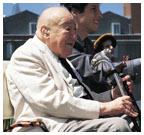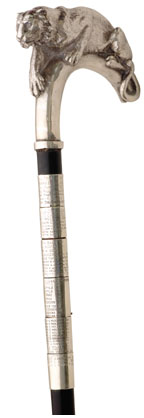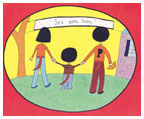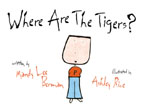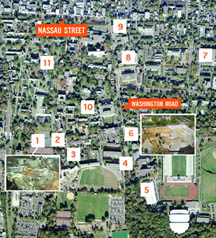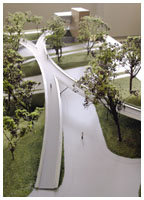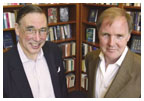Have an opinion about this issue of PAW? Please take a minute to click here and fill out our online questionnaire. It’s an easy way to let the editors know what you like and dislike, and how you think PAW might do better. (All responses will be anonymous.) |
May 11, 2005: Notebook
Carrying the cane at P-rade: a Class of 1925 tradition
Reunions through a child’s eyes
Construction projects on campus: a primer
University Press picks new director in centennial year
Carrying the cane at P-rade: a Class of 1925 tradition
Leonard Ernst ’25, seated at left, has carried the cane signifying the oldest returning alumnus in the P-rade for the past three years.
His classmate, Malcolm Warnock, is shown carrying the cane in 2001. Both plan to attend Reunions this year.
Above, a closeup of the Class of 1923 cane. (photographs by Ricardo Barros) |
Each year before the P-rade, President Tilghman presents the oldest returning alumnus with an ebony cane topped by a silver crouching tiger, and the holder leads the Old Guard through the campus, drawing cheers and locomotives along the way. The cane is named for the Class of 1923, which donated it in 1951, but for the last five years, the treasured artifact has been carried by members of the Class of 1925. This May, as the class celebrates its 80th reunion, Leonard Ernst ’25 and Malcolm Warnock ’25 hope to continue that trend.
Ernst, the cane winner for the last three years, turned 100 in March. Coming back from his home in Tucson, Ariz., to Reunions, he said, gives him a chance to visit relatives in New York City. Warnock, Ernst’s junior by three and a half months, carried the cane in 2001, a year after classmate John Jenney ’25. After reaching Poe Field, Warnock left his golf cart behind, walking past the reviewing stand and waving the cane for the audience. But the crowd was relatively sparse as the Old Guard reached the P-rade’s terminus. “The most exciting part is going through campus,” said Warnock, a retired lawyer from Maplewood, N.J.
Though he’s had to settle for consolation prizes for three years, Warnock insists there’s no rivalry for the cane — he enjoys having a classmate on hand to share the Reunions experience. And for Ernst, carrying the cane has helped to keep Princeton memories fresh in his mind. In April, he recalled with clarity his favorite class as an undergraduate, Professor Edwin Kemmerer’s money and banking course. Kemmerer had traveled to Germany in the early 1920s to help the German government control the hyperinflation that plagued its currency following World War I. “He devoted an entire semester to his experiences there, and it was really fascinating,” said Ernst, an economics major who went on to become the controller at Columbia Pictures.
The Class of 1925 was the largest freshman class to that point, entering Princeton with 581 students. Class members played on the football team’s unbeaten “team of destiny” in 1922, attended lectures by Calvin Coolidge and William Jennings Bryan, and campaigned for changes in the curriculum, including the elimination of a hygiene course for freshmen. After leaving the University, members went on to become governors, college presidents, ambassadors, doctors, clergymen, journalists, and bankers, among other things. Now, only a handful of the men of ’25 remain.
Despite their links to the University’s history, Ernst and Warnock
are not too caught up in nostalgia. They enjoy seeing the changing campus,
talking with Tilghman at the Old Guard luncheon, and meeting Princetonians
from the younger classes. Asked if carrying the cane made him feel like
a representative of his class, or of the Old Guard, Warnock paused and
answered with a chuckle. “No, not really,” he said. “You
feel like a survivor.” ![]()
By B.T.

Reunions 2005, May 26—29, promises a full schedule for returning alumni and their families. The annual alumni-faculty forums will cover topics ranging from foreign policy and the future of journalism to prescription drug prices and religion in politics. The departments of physics and astrophysics will sponsor a Friday-afternoon event honoring the 100th anniversary of some of Albert Einstein’s most important publications, with faculty and alumni speakers on hand to discuss the lasting impact of Einstein’s work.
This year’s P-rade, which begins Saturday, May 28 at 2 p.m., will include bursts of color and creativity, featuring major reunion classes dressed as pirates, firefighters, race-car drivers, golfers, and even a marching insect (the Class of 1970’s “seventy-pede”). The Class of 1980, this year’s 25th-reunion class, will hold its class dinner at Princeton Stadium May 27 and pose for a class picture on the steps of Blair Arch the following day before taking its spot at the head of the P-rade.
President Tilghman will field questions from alumni in a forum in Richardson Auditorium at 10:30 a.m. on May 28. The University’s annual concert begins later that day at 8 p.m., followed by fireworks at 9:15 p.m. A full Reunions schedule from the Alumni Council is available online at http://tigernet. princeton.edu/Events/Reunions.asp.
PAW will include complete Reunions coverage in its July 6 issue. PAW
Online will be posting images of Reunions, Class Day, and Commencement.
![]()
By B.T.

Reunions through a child’s eyes
A family of “tigers” in an illustration by Ashley Rice '96 from Where Are the Tigers?, written by Mandy Lee Berman '92. Below, the book’s cover. (courtesy of the authors)
|
At her 10th reunion, Mandy Lee Berman ’92 came up with the idea of writing a children’s book that would capture a child’s first experience at Reunions. “It struck me that it would be really fun for parents and for grandparents to be able to share their Princeton experience with their children through reading a book,” said Berman, who lives in Brookline, Mass. Her class liked the idea and put up an initial investment of $15,000 to publish 855 copies of Where Are the Tigers?, which Berman wrote and Ashley Rice ’96 of Dallas illustrated, in time for Reunions this year.
Where Are the Tigers? is about a little boy who goes to his parents’ reunion for the first time and searches for real tigers as he follows his parents around campus. When his mother dresses him up in an orange-and-black-striped shirt and draws whiskers on his face for the P-rade, he realizes just who is a real “tiger.”
Proceeds from the book will fund future Class of 1992 community service
activities, says Berman, who has two little tigers of her own, 2-year-old
twins Zoe and Eloise, with husband Seth Berman ’92. Where Are
the Tigers? is available at the U-Store and through its Web site
(www.pustore.com).
![]()
By K.F.G.

Photo by Denise Applewhite |
“I would not have quit college. I regret not having that time. Now I can only see movies about people going to college. … I was fantasizing on my way over to Princeton, ‘I hope my daughter ends up going here.’”
Actor Ben Stiller, asked what he would do differently with his life.
The star of movie comedies including Zoolander and Meet the
Parents, and father of 2-year-old Ella, Stiller spoke to members
of the Class of 2005 April 18 in Richardson Hall. Stiller was the seniors’
choice to speak at Class Day, but appeared earlier because of a scheduling
conflict. ![]()

|
Click the above image to enlarge this aerial photo. Image will appear in a separate browser window and may take longer to load. (Aerial photo courtesy Princeton University Facilities)
Whitman College site (Denise Applewhite)
Science Library Site (Photo by Frank Wojciechowski)
A view of an architectural model of the proposed pedestrian footbridge over Washington Road, looking toward the Carl Icahn Laboratory. (Frank Wojciechowski) |
Construction projects on campus: a primer
President Tilghman presented an update on campus planning to the Council of the Princeton University Community this spring, providing an overview of projects in progress and construction planned over the next five to 10 years. She also discussed the tension between adding new facilities, maintaining a pedestrian campus, and preserving Princeton’s open, park-like character. Several key construction and renovation sites are highlighted on this aerial photo, taken in October 2003.
WHITMAN COLLEGE ( 1 ) , which will be one of the University’s four-year residential colleges, is scheduled to open in the fall of 2007. Constructed on the former site of the Pagoda tennis courts, the Demetri Porphyrios *80-designed complex will house about 500 undergraduates. Nearby BUTLER COLLEGE ( 3 ) is scheduled for major renovations in 2007 and 2008, and the University also hopes to build three single-family MASTERS’ HOUSES ( 2 ) for Whitman, Butler, and Wilson colleges on Elm Drive.
A 200,000- to 250,000-square-foot CHEMISTRY BUILDING ( 5 ) will be built on the site of the old Armory, replacing the laboratories now housed at Frick Laboratory. The Armory location, near Icahn, Thomas, Schultz, and Moffett laboratories and Guyot, Jadwin, McDonnell, and Fine halls, fits the University’s plan to build “neighborhoods” of related academic departments. Said Tilghman: “Chemistry has fundamentally become a discipline whose intellectual spokes are reaching out to almost all of the other sciences.”
Also situated in the sciences neighborhood is the LEWIS SCIENCE LIBRARY ( 6 ) , currently under construction and scheduled to be finished in 2007. The sweeping Frank Gehry design, said Tilghman, will be “a real architectural statement on one of the main thoroughfares on campus.” To tie the neighborhood of the sciences together, the University plans to build a PEDESTRIAN FOOTBRIDGE ( 4 ) over Washington Road. Designed by architect Christian Menn, whose best-known creation in the United States is the Bunker Hill Memorial Bridge in Boston, the structure will serve as a gateway to campus, Tilghman said.
With the ENGINEERING QUADRANGLE ( 7 ) “bursting at the seams,” Tilghman said the School of Engineering and Applied Sciences is due to add laboratory space. Plans may include building a separate home for operations research and financial engineering, expanding the E-Quad, and improving existing facilities.
FRICK LABORATORY ( 8
) likely will be reconfigured into offices for the humanities and social
sciences, which are grouped together in their own neighborhood near the
western end of Washing-ton Road. Undergoing renovation are nearby BURR
HALL ( 9
) , which houses the anthropology department, and JONES HALL
( 10 ) , home of
the East Asian and Near Eastern studies departments. CLIO HALL
( 11 )
is being reconfigured to house the graduate school administration. ![]()
By B.T.

University Press picks new director in centennial year
For the record
As part of its centenary celebration, the Princeton University Press
hosted a May 4 reception at its offices and will co-host a reception
June 17 at the annual meeting of the Association of American University
Presses in Philadelphia. Dates for the events were reported incorrectly
in Notebook May 11.
Walter Lippincott ’60, left, outgoing director of the Princeton University Press, with Peter Dougherty, who becomes director July 1. (Frank Wojciechowski) Princeton University Press 1. Joseph Campbell 2. Richard
Wilhelm (tr.) 3. Georges
Lefebvre 4. Huntington
Cairns 5. Walter Lowrie
(tr.) 6. James Pritchard (ed.) Ancient Near East Vol. 1, An Anthology of Texts and Pictures 7. Richard
Feynman 8. Wing-tsit
Chan 9. G. Polya
10. Northrop
Frye |
The Princeton University Press, one of the country’s oldest and largest university presses, is celebrating its centennial year with a best seller, record revenues, and a change at the top. Walter H. Lippincott ’60 is stepping down as he completes his 19th year as director of the Press; succeeding him July 1 will be Peter J. Dougherty, a 13-year Press employee with 33 years of publishing experience.
“I feel that I’ve accomplished a lot,” said Lippincott. “The Press is in very strong financial shape and is well suited for whatever the future brings.” He said his goal was for the Press to be considered by scholars as having “one of the very best lists” in every field that it publishes; particular strong points are economics, philosophy, political theory, political science, natural history, mathematics, the sciences, and history.
Revenues are expected to approach $21 million this year, the third year in a row of record revenues, Lippincott said. With 200,000 copies in print, the Press’ best-selling title of the past year is On Bullshit by Harry Frankfurt, Princeton philosophy professor emeritus. Lippincott described the book’s success as “the most unusual thing that has happened to me in my Princeton career.”
Patrick Bernuth ’62, a member and former president of the Press’ board of trustees, said Lippincott transformed “an essentially passive, intellectual culture into a more proactive, entrepreneurial, while no less intellectual culture.”
The Press is independent of the University, though its editorial board is composed of five Princeton faculty members and nine of its 15 trustees must be connected with the University. Bernuth praised Lippincott for cultivating a strong relationship between the two.
During his tenure Lippincott sold off the Press’ printing plant, switched from staff to freelance copy editors, started up a new fulfillment system, severed ties to the Princeton Alumni Weekly, reduced staffing by 10 percent during an economic slump, made an early foray into electronic publishing (“an expensive lesson,” Lippincott said), and built a 12,000-square-foot addition to the Press’ building on William Street.
Lippincott also oversaw the opening of an office in England; Yale is the only other American university press with an editorial office outside the country.
Dougherty, who joined the Press as senior economics editor and later became group publisher for the social sciences, has built a reputation for publishing titles in economics and higher education.
Dougherty said the Press will continue to publish monographs, but said he expects more reference books of a scholarly nature and “more trade books of a general nature by very good scholars.” He said the Press sells about 20 percent of its books overseas, and he expects that number to grow. “The ideal is finding great books by great scholars for a world market,” he said.
The Press, which began atop a drugstore on Nassau Street in November
1905, planned to celebrate its centennial with a reception at its offices
May 5 and will co-host a reception June 19 at the annual meeting of the
Association of American University Presses in Philadelphia. A commemorative
book, A Century in Books: Princeton University Press 1905—2005,
lists 100 of the Press’s most distinguished books and includes essays
by five scholars. A free PDF of the book can be found at http://www.pupress.princeton.edu/titles/7937.html.
![]()
By W.R.O.

(Steven Veach) |
Without bars
Black applicants without criminal
records are no more likely to get a job than white applicants recently
released from prison, according to a study of nearly 1,500 private employers
in New York City conducted by sociology professors Devah Pager and Bruce
Western. The study, presented at the 2005 meeting of the Population Association
of America, investigated discrimination against young male minority applicants
and ex-offenders. Pager and Western also found that white high school
graduates were about twice as likely as equally qualified black job seekers
to receive positive responses from New York City employers in the market
for low-wage labor. “Even in a diverse city like New York,”
Pager said in a release, “the evidence of discrimination is unmistakable.”
![]()

In March, Princeton offered admission to 1,214 regular-decision applicants for the Class of 2009, bringing the total of admitted students to 1,807, or 10.9 percent of this year’s record 16,516 applicants. Replies from the candidates were due by May 1.
The group of all admitted students was slightly larger than in recent years — a reflection of the projected 2 percent growth in the size of the freshman class, to 1,220 students. The group is also more diverse, with 41 percent coming from minority backgrounds. Last year, 35 percent of admitted students were members of minority groups. The percentage of sons and daughters of alumni dropped, from 11.2 percent of admitted students in 2004 to 9.9 percent this year.
Dean of Admission Janet Rapelye said the applicant pool exceeded her expectations in both size and quality. Rapelye’s effort to reach students who may be unfamiliar with Princeton seemed to have a positive impact: Students from 6,152 high schools applied, up from 5,382 in 2004, her first year at the University.
In most respects, this year’s class appears similar to its recent
predecessors. About half qualified for the University’s no-loan
financial aid. Fifty-eight percent attended public high schools, 32 percent
private schools, and 10 percent parochial schools. Fifty-four percent
are men, and 46 percent are women. ![]()
By B.T.

(PUAM) |
“UNEXPECTED JOURNEY: Gillett G. Griffin and the Art of the Ancient Americas at Princeton” is the title of an exhibition of pre-Columbian art at the University Art Museum through June 12. A symposium Saturday, May 14, will celebrate the career of Griffin, faculty curator emeritus; describe changes in the field of Mesoamerican art history; and discuss the future of ancient art of the Americas at Princeton. The symposium will run from 8:30 a.m. to 6:30 p.m. in the Multipurpose Room, Frist Campus Center. Advance registration for the symposium is required. Contact Andrea Stearly by phone (609) 258-1741 or e-mail astearly@princeton.edu.
THE SUPREME COURT: CASE AND CONTROVERSY is the
theme of a continuing legal education conference of the Program in Law
and Public Affairs on Thursday, May 26. Scholars, lawyers, and policy-makers
will analyze cases in the headlines this year. The conference will run
from 8:30 a.m. to 5 p.m. in Room A10 of Jadwin Hall. It is free for students,
faculty, and staff who register in advance (lunch not included); the cost
for alumni is $75 and for others is $250, including lunch. ![]()

JASON KAMRAS ’95, a math instructor at John Philip Sousa Middle School in Washington, D.C., has been named the 2005 National Teacher of the Year. Kamras, who receives a year off with pay to speak on education issues, vowed to speak on the need for financial equity for urban schools. Kamras came to Sousa in 1996 through Teach for America, a program founded by Wendy Kopp ’89 that places college graduates in low-income urban and rural schools.
TWENTY-FIVE UNIVERSITY STUDENTS were targeted in federal copyright-infringement lawsuits filed last month by the Recording Industry Association of America. More than 400 students were targeted at 18 schools in an effort to stop what the RIAA termed an “epidemic” over the high-speed Internet2 network. The University received a subpoena April 18 to turn over by May 9 the identities of 25 students accused of illegally sharing music files. “We expect to comply,” said Princeton spokesman Eric Quiñones. Quiñones said the University has worked to educate students about copyright-infringement issues. Targeted students are provided with a list of local lawyers. Students who engage in copyright infringement are subject to disciplinary action, he said.
Caltech astrophysicist KIP THORNE *65, America’s
leading researcher of black holes and gravitational waves, last month
received a Common Wealth Award for Distinguished Service, designed to
reward “the best of human performance worldwide.” Thorne is
one of five honorees, including former Secretary of State Colin Powell
and novelist Amy Tan, who share an award of $250,000. ![]()

Photo by Beverly Schaefer |
President Tilghman and other judges react to a performance by Honey Loquacious,
aka Rachman Blake ’07, the winner of the first All-Ivy Drag Competition
April 16 on the south lawn of Frist Campus Center, at which drag queens
and kings from five schools strutted their stuff for about 500 onlookers.
The celebrity judges ranked the contestants on “gender accuracy,”
“talent,” and “creativity.” Blake, a soccer player,
said that he plans to abandon cross-dressing before beginning his investment
banking career. “It’s just fun, but this doesn’t exactly
fit well with the corporate world,” he said. ![]()


